CHARACTERISTIC OF RAINFALL PATTERN BEFORE FLOOD OCCUR IN INDONESIA BASED ON RAINFALL DATA FROM GSMaP
on
ECOTROPHIC • 7 (2) : 100 - 110
ISSN: 1907-5626
CHARACTERISTIC OF RAINFALL PATTERN BEFORE FLOOD OCCUR IN INDONESIA BASED ON RAINFALL DATA FROM GSMaP
Putu Akyastana 1) 2) 3), Tasuku Tanaka2),M SudianaMahendra 1)
-
1) Graduate Study of Environmental Science, Udayana University
-
2) Center for Remote Sensing and Ocean Sciences (CReSOS), Udayana University
-
3) Graduate School of Science and Engineering, Yamaguchi University
Email: aryastanaputu@yahoo.com
ABSTRAK
Banjir adalah bencana alam yang terjadi hampir di seluruh dunia termasuk Indonesia. Indonesia sangat rentan terhadap bencana karena memiliki karakteristik curah hujan yang cukup besar sepanjang tahun. Bencana banjir adalah salah satu bencana yang sering terjadi di Indonesia. GSMaP adalah salah satu jenis produk satelit curah hujan yang memiliki resolusi temporal satu jam, resolusi horizontal o.1xo.1 derajat, mencakup seluruh dunia dan dioperasikan oleh JAXA. Dalam penelitian ini dilakukan penyelidikan terhadap karakteristik pola curah hujan yang terjadi sebelum banjir terjadi dengan mengolah data curah hujan jam-jaman dari GSMaP MVK di setiap lokasi banjir besar yang terjadi di Indonesia dari tahun 2006-2010. Data banjir besar dikumpulkan dari Dartmouth Flood Observatory (2006-2010) dan Kementerian Pekerjaan Umum Republik Indonesia (2006-2010). Berdasarkan hasil pengolahan data, secara umum Indonesia memiliki dua karakteristik pola hujan sebelum banjir terjadi yaitu curah hujan periode jangka pendek dan curah hujan periode jangka panjang. Berdasarkan hasil kompilasi dan klasifikasi dari 69 kejadian banjir besar lokasi di Indonesia, dari dua pola curah hujan sebelum banjir terjadi diperoleh 42 lokasi atau 60,87% masuk ke dalam kategori curah hujan periode jangka pendek, 27 lokasi atau 39,13% kategori curah hujan periode jangka panjang.
Kata kunci: banjir, pola curah hujan, GSMaP
ABSTRACT
Floods are natural disasters that took place almost all over the world including Indonesia. Indonesia is very vulnerable to disasters because has characteristic a huge amount of rainfall throughout the year. Flood disaster is one of the disasters that often occur in Indonesia. GSMaP is one kind product of satellite precipitation ha!,; one hour temporal resolution, o.1xo.1 degree horizontal resolution, world-wide coverage and operated by JAXA. In this study were investigate the characteristic of rainfall pattern before floods occur by processing hourly GSMaP MVK at each location large flood events occur in Indonesia on 2006-2010. The large flood events data collected from Dartmouth Flood Observatory (2006-2010) and Ministry of Public Works of the Republic of Indonesia (2006-2010). Based on the processing result, generally Indonesia has two characteristic of rainfall patterns before floods occur namely: short term rainfall period and long term rainfall period. Based on the compilation and classification of 69 locations large flood events in Indonesia, from three rainfall pattern before flood occur it obtained 42 locations or 60.87% in the category short term rainfall period, 27 locations or 39.13% in the category long term rainfall period.
Keyword: flood, rainfall pattern, GSMaP
INTRODUCTION
Flood is a natural event where the riverbed was not able to accommodate the flow that occurs from rainfall that fell to the earth's surface. This event will be turned into a disaster when human began to threaten and suffered a loss, whether in the form of death, material and not material (Santosa, 2009).
Floods are costly natural disasters causing fatalities, damages to functional and critical infrastructure, communication and transportation (Kalyanapu, Burian, & McPherson, 2009). In a hydrological sense, a flood is a relatively high flow which overtakes the natural channel provided for runoff (Chow, 1956 in Rakhecha & Singh, 2009). Based on WMO in a hydro meteorological sense, a flood can be defined as
a situation over a region where the rainfall amount is more than a certain amount of the normal for that region (Rakhecha & Singh, 2009).
The Indonesian Maritime Continent is a one of the region characterized as a huge amount of rainfall throughout the year, and plays the essential role as a center of atmospheric heat source of earth climate system (Ramage, 1968). The Indonesia Maritime Continent is currently the region of the most intense convective activity and thus generates frequent torrential rainfall (Yamanaka, et al., 2008). Indonesia has the highest rainfall in comparison with nine other tropical regions of the world because Indonesia is surrounded by sea (Anonimus, 2009). Therefore, Indonesia is very vulnerable to disasters. Flood disaster is one of the disasters that often occur in Indonesia. One kind of the causes of floods in Indonesia is a large amount of rainfall.
GSMaP (Global Satellite Mapping of Precipitation) has been developed by a Japanese research team under the support of Japan Science and Technology Agency (JST) in 2002 until 2007 and continued by Japan Aerospace Exploration Agency (JAXA) in 2007 until present. GSMaP is a global high-resolution satellite-based precipitation product (HRPP), as well as TRMM 3B42 (TMPA), CMORPH, PERSIANN, and many other products are (Seto, 2010). GSMaP is a near-real-time rainfall observation with one hour temporal resolution, word-wide coverage, primary data source, passive microwave observation and operated by JAXA (Okamoto, et al., 2007).
In this study, the characteristic of rainfall pattern before floods occur in Indonesia were investigates by using GSMaP data. The aim of this research is to determine the rainfall pattern that occurred before the flood at each location of flood events based on GSMaP data. The result of this research can provide information on rainfall patterns that occurred before the floods in the region of Indonesia based on GSMaP data, so it can be used as a reference in determining mitigation flood disaster and the early warning system.
METHODOLOGY OF RESEARCH
The research focused in the areas where the large flood events occur in Indonesia. Data was used in this study:
-
a. Large flood events in Indonesia on 2006-2010 from Dartmouth Flood Observatory.
-
b. Large disaster events in Indonesia on 2006-2010 from Ministry of Public Works of the Republic of
Indonesia.
-
c. Hourly rainfall GSMaP MVK version 4.8.4 in 2006 and version 5 in 2007-2010.
The rainfall pattern before floods occur in Indonesia is obtained by processing hourly average rainfall GSMaP MVK at each location large flood events occur in Indonesia on 2006-2010. The number of floods data being processed is 69 data. To get the pattern of rain before the flood occur, the average rainfall is searched an average rainfall of seven days before the floods came, and two days after the flooding occurred. The average hourly rainfall are obtained and then plotted in graphical form. Perform classification and clustering of rainfall patterns that occurred before the flood events by using the graph of averages hourly rainfall.
RESULT AND DISCUSSION
Based on the processing result, generally Indonesia has three characteristic of rainfall patterns before floods occur namely: short term rainfall period and long term rainfall period. Short term rainfall period is an accumulative rainfall for several hours until one day. Long term rainfall period is an accumulative rainfall from several day or more than one day. Fig. 1 shows the characteristic rainfall of the three rainfall
pattern before floods occur.
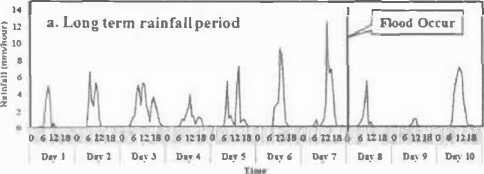


o ,1:ao tU)IO cuJ10 •u110 ,u110 ,uno ,u110 ,uao ,uuo ,u1,
D ... l 08!'2 Drcl On-4 Dw5 D.yl 01J7 DfTI D•^·, Da•lO T^
Fig.1 Rainfall pattern before floods occur (Aryastana, 2012)
Based on the compilation and classification of 69 locations large flood events in Indonesia, from three rainfall pattern before flood occur it obtained 42 locations or 60.87% in the category short term rainfall period, and 27 locations or 39.13% in the category long term rainfall period (see Table 1).
Table 1 The number of rainfall pattern before flood occur in 2003-2007
Number of Rainfall Pattern
|
No |
lslan/Region |
Long Term Rainfall Period |
Short Term Rainfall Period |
|
l |
Sumatra |
6 |
6 |
|
2 |
Java |
13 |
21 |
|
3 |
Kalimantan |
3 |
3 |
|
4 |
Sulawesi |
3 |
3 |
|
5 |
Nusa Tengtara |
2 |
8 |
|
6 |
Papaua |
1 | |
|
Total |
27 |
42 | |
|
Percent |
39,13% |
60,87% |
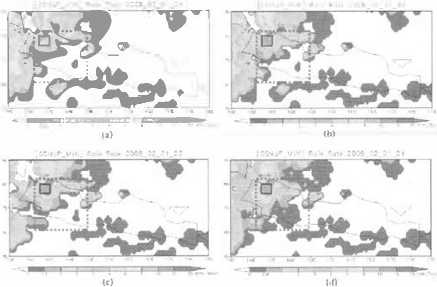
Fig. 2 shows the rainfall condition before floods occur in Teunom district, Aceh .Jaya regency, Aceh province. Floods occur in Teunom district on 18th October 2007 at the morning. The characteristic rainfall pattern before floods occur in Teunom district show accumulative rainfall for more than one day. The rainfall pattern before floods happened in Teunom district is long term rainfall period.

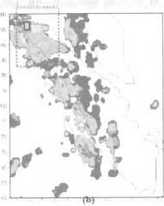
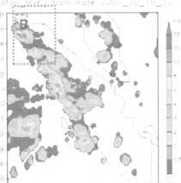


On....,, o,,,.,..., on•• On•wt fl,t,,..... nn•, <'kt..,, ott.-... On...,, tkf.....,.
11 !I.'!!"' I! !OI^ (.l,Jf1,-. t• :,,• I'!·^ 1',HD• 1·_.?tr 1•.!•••1' 1".H"^ JO ,!j•r"
·-
Fig. 2 Rainfall Condition before Floods Occur in Aceh Jaya Regency (Aryastana, 2012}
Fig. 3 shows the rainfall condition before floods occur in .Jakarta province. Fig. (a) until 3(t) show hourly rain rate of GSMaP MVK before floods occur. Fig. 3(g) shows average hourly rainfall of GSMaP MVK in area floods occur from 25th .January 2008 until 3rd February 2008. Floods occur in Jakarta province on 1st February 2008 at 11:00 local time. The characteristic rainfall pattern before floods occur show accumulative rainfall for 11 hours. The rainfall pattern before floods happened in .Jaka1ta province is short term rainfall period.
.Java Island has a sho1t term rainfall peiiod more
|
—^— AruanJ Jakanapruttacc ....... AroaiidWeMJavaprmtacr a |
^J Hood Occur I |
0 • UltD • Ull O • c•u 6UllCI .u .. , • Hiit 6 Ul,l,O 6 H18 6 11110 61Jlll:
......,, J•••-^ J...., b-•^ Ju••• '••••• ,-... r,.,...n +"'"'"' r..,....
—^—•^—n—»—^^———M—t— •.— •—
i— (..
Fig. 3 Rainfall Condition before Floods Occur in Jakarta Province (Aryastana, 2012)

[GSMaP NBKjThnc Serie» A'CiamofRaiufaB 1 frl⅛iυ<a<(!l ∣∣o
than long term rainfall period before flood occur, because it has high population density around 1000 people/km2 (Hidayat, 2009). Land use change affects watershed hydrological characteristic by altering soil absorbance to rainfall. Rainfall reaches the ground by vegetation interception and through fall. Some of water used in evaporation process and the rest of rainfall infiltrate to the soils. Amount of water absorb by soil was depend on soil physical condition. Land use change affects soil physical condition by altering porosity that in turn changes the capacity of water absorbance (Wahmg, Tala'ohu, & Dariah, 2005). The intensive deforestation and inappropriate land cultivation as in the most of river basin in .Java, causes not only sedimentation in the river bad but also in the reservoir. The effect of land cover decreases though still plays its moderating role in diminishing the severity of heavy floods (Abbasz.adeh Tehrani, M. F. Makhdoum, & Mahdavi, 2011).
Fig. 4 shows the rainfall condition before floods occur in Labuapi district, West Nusa Tenggara province. Floods occur in Labuapi district on 10th .Janua1y 2009 at 03:00 local time. The characteristic rainfall pattern before floods occur show accumulative rainfall for eight hours. The rainfall pattern before floods happened in Lubuapi district is sho1t term rainfall period.
Nusa Tenggara has short term period rainfall pattern more than long term period rainfall pattern

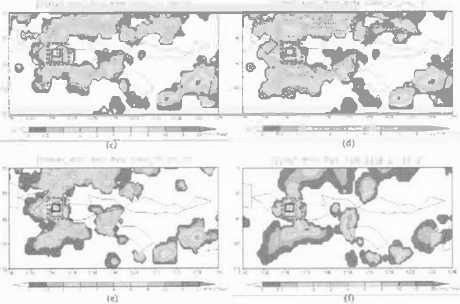
?«
■5 10
1 •
τ »
1 • % '
(GSMaP M∖ KJ I Inic-SerieiAx CrageofRalnUi ∣l> ∣j,. > l∣∙..o∙∙ ∣.
|
-\r..•l•lt.61,,'!df>ll"kl ----VmN XXM LeetokR^MQ -··· 1r--, 1,..,91,L ,.._. |
^J IjTooft Oecur ∣ I 1 |
O 6 UiK O «121*0 6 UlKO 6 Uis (I O UiB O 6 UlBO 6 1218 O ft UIX O ft U IB O 6 12» "‘•••• Januar. Jaeuw Janaw Joaaure J*o.w Joanart Jmuhm Jmmm ba.w
.\. lOOf 4. ?009 !I, :oft 6. lN't ..,_ 1*luf '-.:nit t. :nllf IO !O,,f II !<111'9 I^. ?auf
....
Ill
Fig. 4 Rainfall Condition before Floods Occur in Labuapi District (Aryastana, 2012}
before flood occur, because most areas where the flood occur (West Lombok, East Lombok, West Rasanae, Ende and Beh1) have the soil type are clay, sandy clay, tuff and kambisol (Anonimus, 2007; Dwi, 2010). This soil type has the characteristics of water absorption is slow due to low permeability conditions (Dwi, 2010). Small value of permeability it make difficult the water to infiltrate to the soil. This situation make the surface runoff will increase rapidly. Increased the surface runoff will speed up the inundation.
Most of flood events on 2006-2010 occurred at the night until early morning, this is because the precipitation in the Maritime Continent is mostly concentrated over islands in the afternoon and evening (Qian, 2007).
CONCLUSION
Based on hourly rainfall data from GSMaP in 2006-2010, Indonesia has two rainfall patterns before floods occur are short term rainfall period and long term rainfall period.
REFERENCES
Abbas7adeh Tehrani. N., M. F. Makhdoum, M., & Mahdavi. M. (2011). Studying the Impacl, of Land Fse Changes on Flood Flows by Using Remote Sensing (RS) and Geographical Information System (GIS) Techniques-a Case Study in Dough River Watershed. Northeast of Iran. Journal of .Hnvironmenlal Research. Vol 1. No. 2. Aulum and Winier, 1-14.
Adrian, E.. & Susanlo. R. D. (200;3). Idcnlification of Three Dominant Rainfall R<..-gions within Indonesia andTheir Relationship lo Sea SurfaceTempcralurc. Internalional .Journal cf Climatology 23, 14;35-1452.
i\nonimus. (2007). Slalislik Pembangunan Balai Pengelolaan Daerah Aliran Simgai Benain Noelmina. East Nusa Tcnggara: Balai Pengclolaan DAS Benain Noclmina.
Anonimus. (2009). Ancaman Bw^jir Semakin Besm·. Retrieved ,June 2. 2012, from GREEN CrrIZEN INDONESIA: http://wargahijau.org/index.php?oplion=mm_co nlenl&,iew=arlicle&id=56:ancaman-banjir-scmakin-hcsar&cati<l=11:grcen-activilics&Ilcmid=16
i\ryaslana, P. (2012). Flood Assessmenl i11 Indonesia Based 011 Rainfall Dalafrom GSMaP (11iesis). Dcnpasar: Post Graduate Program Fdayana University.
Dwi, I. (2010). Kondisi Tanah Nusa Tenggara. Retrieved .June 26, 2012, from hllp://onc-geo.blogspol.jp/2010/01/ kondisi-lanah-nusa-lenggara.hlml
Ilamzah, M. A., Samad, 8., Kurniawan. R., & Tirlasari, A. (wcr). Pallem of Spatio-Temporal Rainfall Dislri-b11tio11. Makasar: Center for Environmental Studies, l lasanuddin University.
Ilidayat, F. (2009). Floods cmd climate cha11ge -observations from .Java. Solo, C'entral-,Java, Indonesia: Center for River Basin Organizations and Management.
Kalyanapu, A..J., Burian, S..J.. & McPherson, T. N. (200<)). Effect of Land Use-Based Surface Roughness on lly-drologic Model Output. .Journal ofSpalial Ilyc/T'Oloyy. Vol. 9, No. 2. 51-7t.
Okamoto, K., Iguchi, T., Takahashi, N.. Ushio, T., i\waka, ,J., Kozu,T., cl al. (2007). lIigh Precision and High Resolution (,lohal Precipitation Map from SaleJlilc Data. Pro-eeeding nf /.','AP (pp. 506-509). Niigala, .Japan: IEICE.
Qian, ,J.-11. (2007). Why Precipitation is Mostly Concentrated over Islands in Marilime C'onlinenl. .Journal of 111e Atmospheric Sciences, Vol. 65, 1428-1441.
Rakhccha, P. R., & Singh. V. P. (2009).App/iedl!ydromeleo-rology. New Delhi: Springer.
Santosa, K. C. (2009).Analisa Hidrolika Sungai Scbagai l'paya Penanggulangan Banjir Kali Mlinjo Kabupatcn Kediri. Pmceeding llasil Pe11elitia11 Mahasiswa Magisler Teknik Sipi/ lvfinal Pe11gelolaan Sumber Daya Air ModularA ngkata112007(pp. IX-1). Malang: Program Pasca Sarjana l'niversitas Brawijaya Malang.
Selo, S. (2010). GSMuP: An Overview of the Algorithm and Reviews qf Applicalion Studies. Tokyo: Earth ^'yslcm Science lo Society.
Watung, R. I.., Tala'ohu. S. II., & Dariah. A. (2005). Land llsc Change and Flood Mitigation in Cilarum and Kadigarang Watershed<;. Prosiding Mull{/imgsi Per-ta11ic111 ISBN: 979-9474-42-6 (pp. 41-54). Bogor: Balai PcnelilianTanah.
Yamanaka, 1\1. 0., Ilashiguchi, II., Mori, S., Wu, P.-M.. Syamsudin, F., Manik, T., cl al. (2008). llARIMAl T Radar-Profiler Network over the Indonesian Maritime Continent:/\ GEOSS EarlyAchievement for llydrologi-cal Cycle and Disaster Prevention. Journal ofDisasler Research Vol-3 No. 1. 78-88.
103
Discussion and feedback